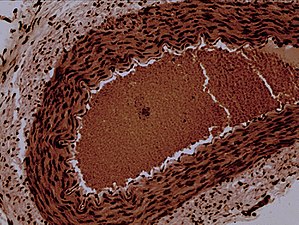Arterioles
| Arteriole | |
|---|---|

Types of blood vessels, including an arteriole and artery, as well as capillaries.
|
|

Rabbit arteriole at 100X
|
|
| Details | |
| Identifiers | |
| Latin | arteriola |
| TA | A12.0.00.005 |
| FMA | 63182 |
|
Anatomical terminology []
|
|
An arteriole /ɑːrˈtɪəri.oʊl/ is a small-diameter blood vessel in the microcirculation that extends and branches out from an artery and leads to capillaries.
Arterioles have muscular walls (usually only one to two layers of smooth muscle) and are the primary site of vascular resistance. The greatest change in blood pressure and velocity of blood flow occurs at the transition of arterioles to capillaries. The decreased velocity of flow in the capillaries increases the blood pressure, due to Bernoulli's principle. This induces gas and nutrients to move from the blood to the cells, due to the lower osmotic pressure outside of the capillary. The opposite process occurs when the blood leaves the capillaries and enters the venules, where the blood pressure drops due to an increase in flow rate. Arterioles receive autonomic nervous system innervation and respond to various circulating hormones in order to regulate their diameter. Retinal vessels lack a functional sympathetic innervation. Further local responses to stretch, carbon dioxide, pH, and oxygen also influence arteriolar tone. Generally, norepinephrine and epinephrine (hormones produced by sympathetic nerves and the adrenal gland medulla) are vasoconstrictive acting on alpha 1-adrenergic receptors. However, the arterioles of skeletal muscle, cardiac muscle, and pulmonary circulation vasodilate in response to these hormones when they act on beta-adrenergic receptors. Generally, stretch and high oxygen tension increase tone, and carbon dioxide and low pH promote vasodilation. Pulmonary arterioles are a noteworthy exception as they vasodilate in response to high oxygen. Brain arterioles are particularly sensitive to pH with reduced pH promoting vasodilation. A number of hormones influence arteriole tone such as angiotensin II (vasoconstrictive), endothelin (vasoconstrictive), bradykinin (vasodilation), atrial natruretic peptide (vasodilation), and prostacyclin (vasodilation).
...
Wikipedia
